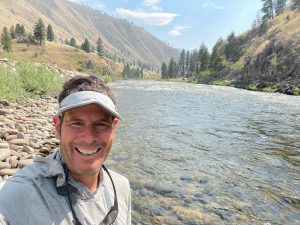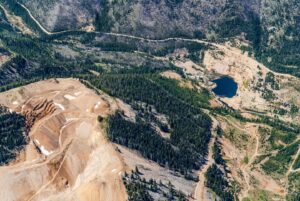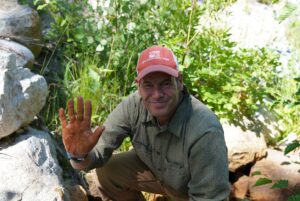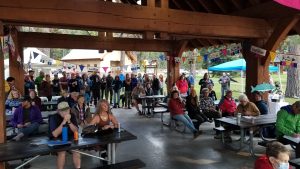I first kayaked the South Fork of the Salmon some 24 years ago and was stunned at the ruggedness, beauty, and ecological significance of the river. I was so inspired by the South Fork and other rivers in Idaho that I moved here the next year. I have spent the last 23 years working for the Idaho Conservation League to protect wild rivers and wild landscapes.

Mining and rivers don’t get along very well. According to the Environmental Protection Agency (EPA), mining is the number one toxic polluter in the U.S. Desired minerals like gold are often bound in the ore along with contaminants like arsenic, lead, selenium, or sulfides. While the process of blasting, crushing, and milling the rock allows mining companies to extract the desired minerals, these mining activities also release and mobilize the contaminants. Mines utilized caps and liners and other design features to contain these contaminants, but there are still far too many examples in which the pollution is not fully contained. Rainwater, snowmelt, groundwater, rivers, and wind can all transport these pollutants away from a mine—and into special places and communities we care about.
I know. I spent 6 years working as river guide on the Ocoee River in eastern Tennessee downstream of a historic open-pit copper mine. The river had great whitewater but no native trout because of the metals contamination from historic mining.
Idaho has its own share of historic pollution, as in this recollection of the Coeur d’Alene River:
“The metals stunt fish populations in 66 miles of the river and its tributaries, with some stretches too toxic to support aquatic life. They also pose potential health risks for people who swim or float down the river, or recreate along the shore, government officials said.”
– Spokesman Review, August 5, 2010
We repeatedly fail to learn from past mistakes. Idaho’s “state-of-the-art,” “zero-discharge,” non-polluting Grouse Creek Mine opened in 1994. The mine was cited for 258 water quality violations from May 1994 to June 1996 and had a run of 210 straight days of violations starting in October of 1998. The Forest Service had to post signs which warned, “Caution, do not drink this water.”
Mining has not improved as much as it should have since then. A 2017 study examined the track records of the 27 gold mining companies that are responsible for 93% of gold production in the U.S. The study found that every single one of these modern, state-of-the-art mining projects accidentally spilled cyanide, mine waste, diesel fuel, or other hazardous materials. This includes cyanide vat leach mines…

That brings us to the Stibnite Gold mine, yet another “state-of-the-art” mine. What makes the Stibnite Gold mine potentially so much worse is the scale of the project and the massive amount of waste mining would create. The project would double the already troublesome footprint from past mining. The quality of the gold ore is so low that you have to use cyanide to sift through 16 tons of rock to produce just 1 ounce of gold. The other 99.99% is mine waste that gets left on site, along with the cocktail of toxins that are now mobilized. Over 100 million tons of toxic mine waste would be generated and left on site. The Tailings Storage Facility and accompanying buttress would be over 2 miles long, the approximate length of Ponderosa State Park peninsula. At a height of 460 feet tall, the tailings would bury the Little Ski Hill at 405’ tall.
Even more problematic is its location in the headwaters of the East Fork South Fork Salmon. When the hydroelectric dam at Blowout Creek failed in the 1960s, the plume of debris washed down Meadow Creek, down the East Fork South Fork, down the South Fork, and down the Main Salmon where it was visible in Riggins. If something bad happened at Stibnite, it would not stay at Stibnite.
We are also concerned about contaminants along the transportation route, other travelers on these routes, and the communities that this hazardous waste would be trucked through. Trucks would haul:
- 5,800,000 gallons of diesel fuel in 580 trips per year
- 7,300 tons of ammonium nitrate in 304 trips per year, and
- 4,000 tons of sodium cyanide in 167 trips per year.
Perpetua is trying to offset these impacts with measures like restoring river sections and wetlands but the scale of the negative impacts from mining are orders of magnitude too large to be offset. This is why the Forest Service’s own analysis admits that the best thing for the environment is if the project never goes forward—even if all the existing mine waste is left completely as is.
The Final Environmental Impact Statement signals the next stage in the fight for the South Fork Salmon; it is not the final word. There are still several state permits that have been sent back to the drawing board after ICL and our partners pointed out significant deficiencies in the permits that would have dewatered streams, contaminated the air with toxic levels of arsenic, and failed to offset impacts to wetlands. We are still awaiting the next stages for these permits.

In my first years at the Idaho Conservation League, the Forest Service started the Environmental Impact Statement for another open-pit cyanide leach mine—the Atlanta Gold mine in the headwaters of the Boise River, which is the source for 30% of the City’s drinking water. It was revealed that the City of Boise would likely be the lead responder if there was an accident along the riverside transportation route, leaving the city vulnerable if other emergencies arose during that time. In light of these concerns, the Mayor and City Council passed a resolution opposing the mine. At the same time, keen-eyed activists noticed that the mining company was illegally discharging arsenic into the Boise River headwaters from a mine exploration project. The City’s action and litigation by the Idaho Conservation League over the arsenic pollution stopped the mine.

Last week, members of the river community gathered at a Rally for the South Fork Salmon hosted by our partners Save the South Fork Salmon and Advocates for the West. A member from the Nez Perce Tribe gave an impassioned speech about the continued importance of the South Fork to the Tribe. Now is the time to redouble your support for the Idaho Conservation League and our partners. Talk to your neighbors and community leaders and share your concerns. Be a voice for the South Fork. The fight has just begun.

